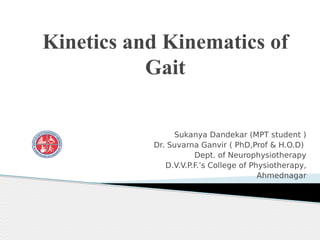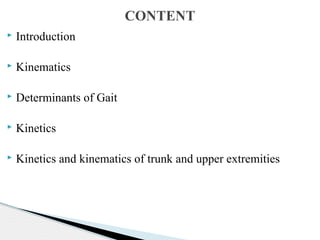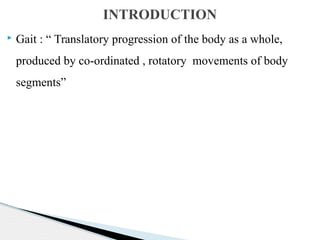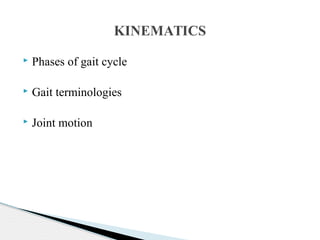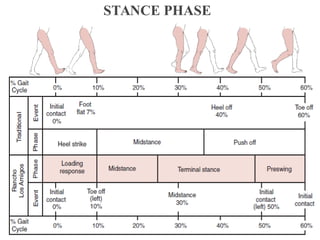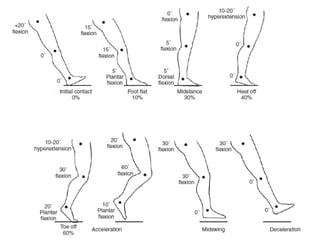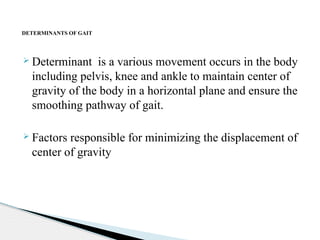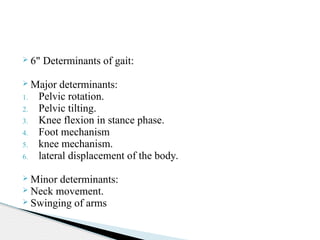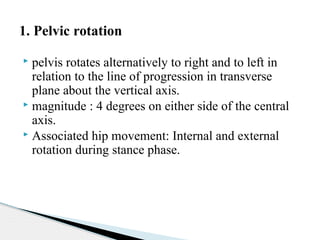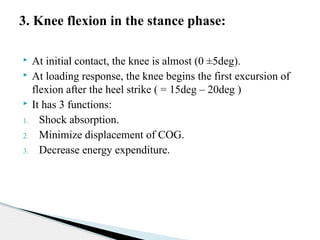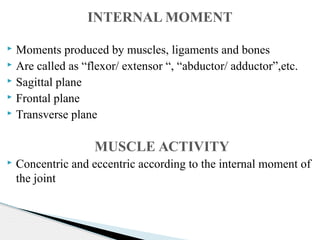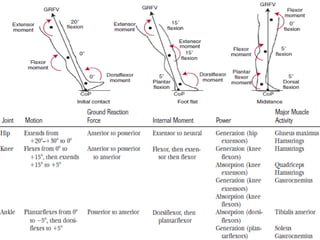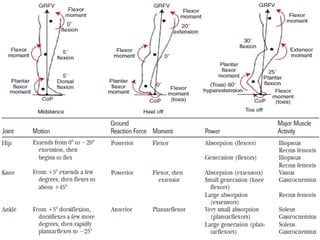Kinematics and kinetics of gait
- 1. Kinetics and Kinematics of Gait Sukanya Dandekar (MPT student ) Dr. Suvarna Ganvir ( PhD,Prof & H.O.D) Dept. of Neurophysiotherapy D.V.V.P.F.ŌĆÖs College of Physiotherapy, Ahmednagar
- 2. ’üĮ Introduction ’üĮ Kinematics ’üĮ Determinants of Gait ’üĮ Kinetics ’üĮ Kinetics and kinematics of trunk and upper extremities CONTENT
- 3. ’üĮ Gait : ŌĆ£ Translatory progression of the body as a whole, produced by co-ordinated , rotatory movements of body segmentsŌĆØ INTRODUCTION
- 4. ’üĮ Phases of gait cycle ’üĮ Gait terminologies ’üĮ Joint motion KINEMATICS
- 5. ’üĮ Begins ŌĆō heel of reference extremity contacts the supporting surface ’üĮ Ends- heel of same reference extremity contacts the ground again ’üĮ Phases : 1. Stance - reference extremity contact with the ground constitutes 60% 2. Swing ŌĆō reference extremity not in contact with the ground Constitutes 40% 3. Double support- 2 intervals where the weight is transferred from one extremity to another GAIT CYCLE
- 6. STANCE PHASE
- 7. SWING PHASE
- 8. Approx ROM needed in normal gait and time of occurrence of maximum flexion and extension positions for major joints determined by joint angles. 1. Sagittal plane joint angles 2. Frontal plane joint angle 3. Transerse plane joint angles JOINT MOTION
- 10. ’āś Determinant is a various movement occurs in the body including pelvis, knee and ankle to maintain center of gravity of the body in a horizontal plane and ensure the smoothing pathway of gait. ’āś Factors responsible for minimizing the displacement of center of gravity DETERMINANTS OF GAIT
- 11. ’āś 6" Determinants of gait: ’āś Major determinants: 1. Pelvic rotation. 2. Pelvic tilting. 3. Knee flexion in stance phase. 4. Foot mechanism 5. knee mechanism. 6. lateral displacement of the body. ’āś Minor determinants: ’āś Neck movement. ’āś Swinging of arms
- 12. ’üĮ pelvis rotates alternatively to right and to left in relation to the line of progression in transverse plane about the vertical axis. ’üĮ magnitude : 4 degrees on either side of the central axis. ’üĮ Associated hip movement: Internal and external rotation during stance phase. 1. Pelvic rotation
- 13. ’üĮ The pelvis tilts downward on swing leg (on the side which is opposite to that of weight bearing leg) along the frontal plane around sagittal axis. ’üĮ magnitude: 5 degrees. ’üĮ Associated hip movement: hip adduction in stance phase and hip abduction in the swing phase. 2. Pelvic tilting
- 14. ’üĮ At initial contact, the knee is almost (0 ┬▒5deg). ’üĮ At loading response, the knee begins the first excursion of flexion after the heel strike ( = 15deg ŌĆō 20deg ) ’üĮ It has 3 functions: 1. Shock absorption. 2. Minimize displacement of COG. 3. Decrease energy expenditure. 3. Knee flexion in the stance phase:
- 15. ’üĮ At mid- stance, the extension of knee reaches (5 deg) in flexion. ’üĮ At terminal stance, the knee joint reaches 0 degof extension to start the first excursion of knee extension. ’üĮ At pre-swing, the knee joint flexes up to 10deg flexion to start the second excursion of knee flexion
- 16. Early in the stance phase: ’üĮ Foot dorsiflexed ,knee extended extremity max length COG reaches lowest point in a downward displacement. Late in the stance phase: ’üĮ Foot plantar flexed knee slight flexion maintain COG in its beginning of progression with minimum displacement. 4. & 5. Foot and knee mechanism:
- 17. ’üĮ COG displaced laterally over the weight bearing extremity twice during the cycle of motion in the horizontal plane. ’üĮ The motion is produced by the horizontal shift of pelvis and relative adduction of hip. Magnitude: 4.5 cm each stride 6. Lateral displacement of body and COG
- 18. 1. Increase the efficiency and smoothness of pathway of gait. 2. Decrease the vertical and lateral displacement of centre of gravity to two inches excursion. 3. Decrease the energy expenditure. 4. Make gait more graceful. Function of the 6 detrminants of gait
- 19. ’üĮ Moments produced by muscles, ligaments and bones ’üĮ Are called as ŌĆ£flexor/ extensor ŌĆ£, ŌĆ£abductor/ adductorŌĆØ,etc. ’üĮ Sagittal plane ’üĮ Frontal plane ’üĮ Transverse plane MUSCLE ACTIVITY ’üĮ Concentric and eccentric according to the internal moment of the joint INTERNAL MOMENT
- 22. ’üĮ Walking accomplished by - 1. Bursts ŌĆō concentric contraction ŌĆō positive work 2. Eccentric contraction- negative work ’üĮ Body saves energy by passive exchange of potential and kinetic energy ’üĮ Initial contact ŌĆō lowest potential energy ’üĮ As the leg moves into midstance potential energy rises exchange for kinetic energy ENERGY REQUIREMENTS
- 23. ’üĮ Potential energy curve drops at the same time as the kinetic energy rises ’üĮ Sum of potential and kinetic components energy saving ’üĮ Kinetic and potential energy not matching energy conservation reduced
- 24. ’üĮ Trunk remains in erect position during normal free speed walking on normal ground, varying only 1.5 degrees. ’üĮ Sagittal plane: Heel strike flexion of HAT opposing moment provided by hip extensors ’üĮ Frontal plane: COM medial to hip joint moment balanced by hip abductor moment of the supporting extremity KINEMATICS AND KINETICS OF THE TRUNK
- 25. ’üĮ Initial contact pelvis rotates counter clock wise trunk rotates clock wise ’üĮ Vice versa ’üĮ Trunk motion prevents excess body motion and balances rotation of the pelvis ’üĮ Mediolateral translations(side to side motions): Trunk to right-right heel strike to left toe off
- 26. ’āś Arm swinging ŌĆō opposite to legs and pelvis but similar to trunk ’āś Counter balances forward swinging of the leg and decelerates rotation of the body ’āś Forward swing :supscapularis, teres major and lattissimus dorsi ’āś Backward swing :middle and post deltoid, teres major and latissimus dorsi ’āś Forward swing medial rotators eccentrically control rotation ’āś post deltoid eccentrically to restrain forward swing KINEMATICS AND KINETICS OF THE UPPER EXTREMITIES
- 27. ’üĮ Joint Structure and Function :A Comprehensive Analysis- Fifth Edition by Cynthia C. Norkins ’üĮ Physical Rehabilitation ŌĆō Fifth Edition by Susan B OŌĆÖ Sullivan ’üĮ Kinesiology The Mechanics and Pathomechanics of Human Movement ŌĆō Second Edition by Carol A. Oatis REFERENCES
